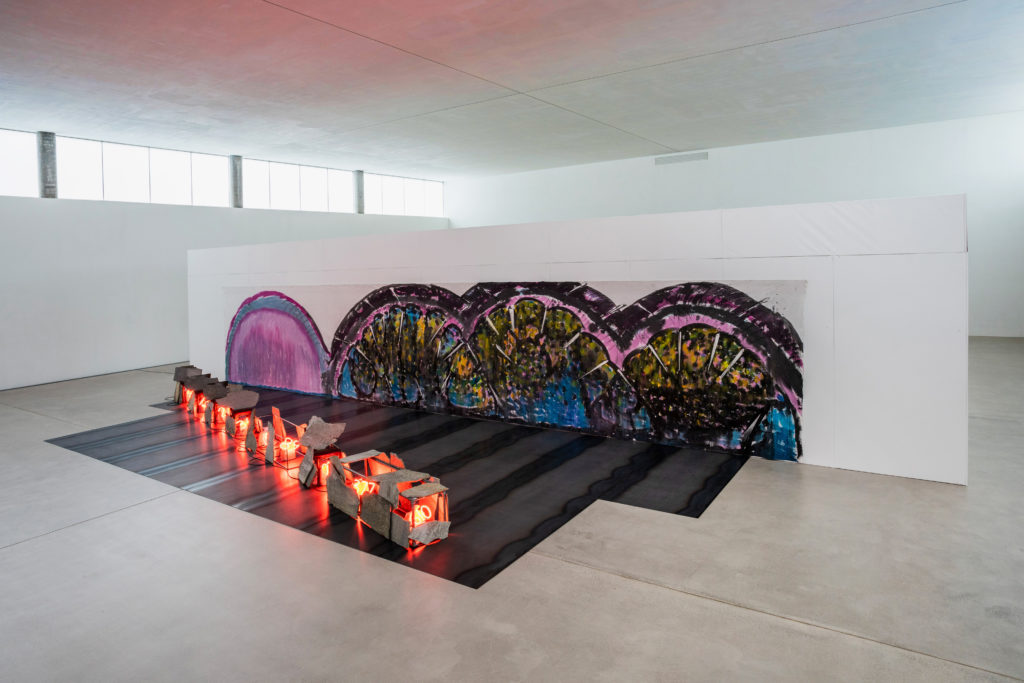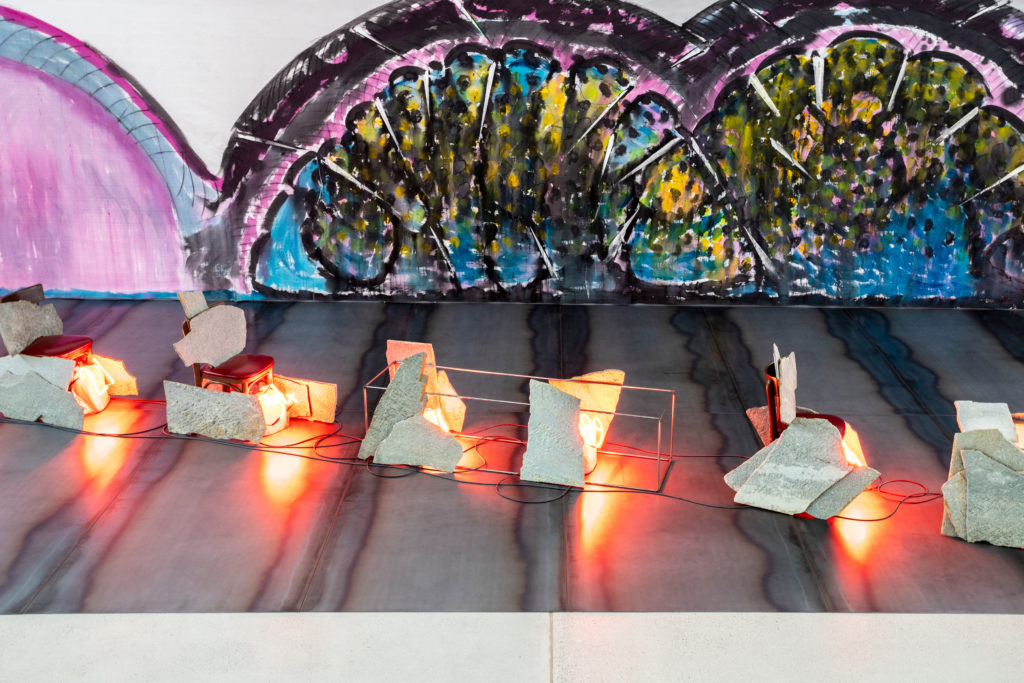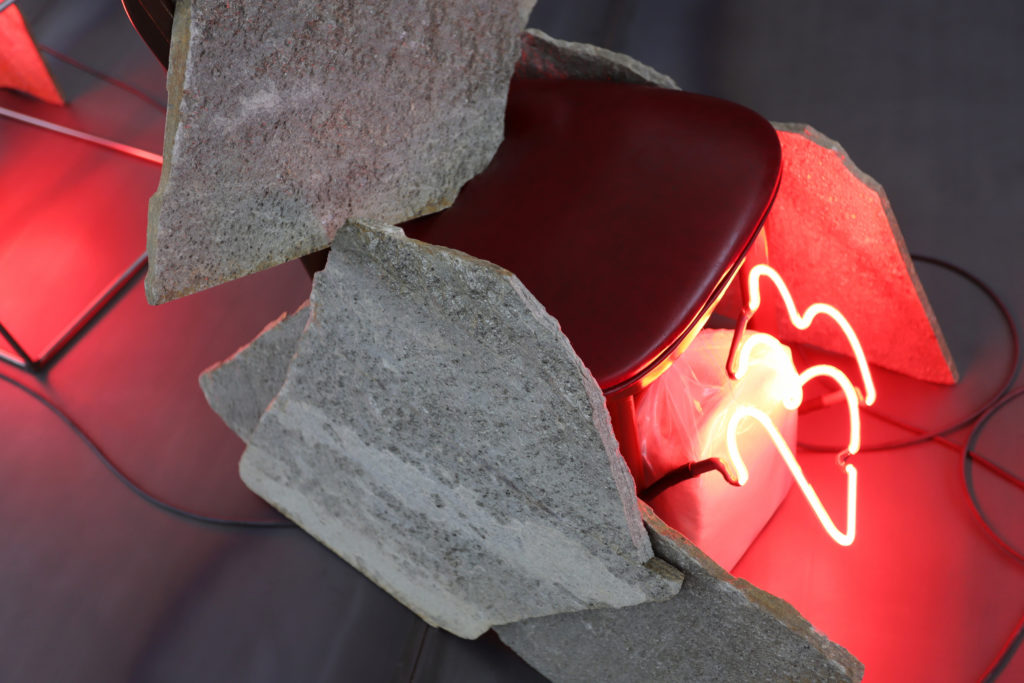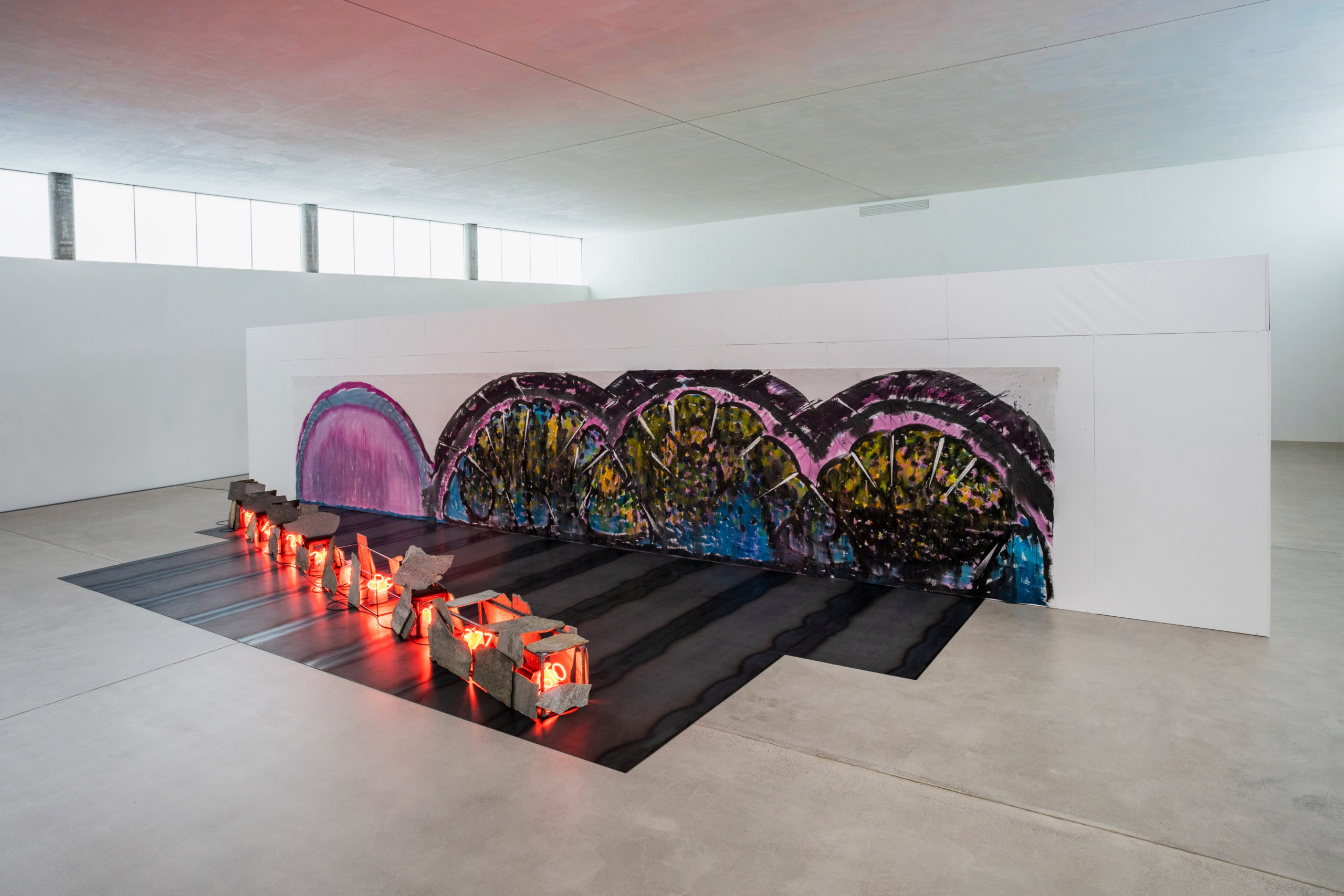“As Much Phantasy as Possible”
by Christel Sauer

Mario Merz
Senza titolo, 1989
Mixed media on cotton fabric, steel, stone, neon numerals, clay, chairs
266 x 1443 x 500 cm
Raussmüller Basel
In 1989 Mario Merz had two solo exhibitions at major American museums: in the spring at the Museum of Contemporary Art (MOCA) in Los Angeles, and in the autumn at the Solomon R. Guggenheim Museum, New York.1 In both cases he related his installation to the architectural setting, and the character of each show was correspondingly different. In New York, the spiral of the Wright building offered Merz a welcome basic structure, while in Los Angeles the intention was to give three neutral large rooms in the new museum2 a particular character through his works and their configuration. In the catalogue of the MOCA exhibition, curator Mary Jane Jacob describes how Merz developed the entire show on site, how he reacted to the city and selected his works specifically for the building.3 “Like stanzas in a poem,” she writes, “the rooms are structured with an internal rhythm and harmony; like individual words within poetic verse, each element of the exhibition is open to a variety of interpretations”.4
Senza titolo was created in MOCA’s South Gallery. It was the only work in the exhibition in which painting played a role. With its size and colourfulness, the canvas placed a bold accent in the installation. Unlike in the case of the other works, Merz had brought the finished painting with him from Italy.5 With a length of nearly 14.5 metres, it occupied an entire gallery wall. Merz secured the cloth loosely with steel nails and hung it in such a way that it rose upwards and extended outwards directly from floor level. The painting shows four semicircles, of which one stands alone on the far left, while the remaining three successively overlap one another on the right. Owing to the low hanging of the canvas, they seem to rise from the floor like mountains. In their dome-like shape, they corresponded within the exhibition to the igloos that Merz had placed in the rooms. In their colourful palette, however, they set themselves apart from all the other works.
Merz has painted a picture of light and shadow, of dark caverns in which organic matter seems to develop and expand in eruptive fashion, while in the hemisphere on the left, a suggestive pinkish-purple depth opens up beneath a pale grey arch. In the adjacent forms, this pink is enclosed in much black and overlaid by a dramatic painterly event. Distinguishing themselves from the dark ground of the “caverns” are blue surfaces, like rippling water. Emerging from these in turn are dappled green and yellow shapes in rich hues – accompanied by black dots and pointed white lines, which resemble piercing flashes of light and seem to bind together the proliferating forms. The manner of painting is spontaneous and full of energy, with layers of colours and different techniques. In places, the size of the cloth was insufficient to match the momentum of Merz’s brush: one of the semicircles is sliced across the top, a second along its right-hand edge. Both probably continued onto the wall against which Merz painted the canvas.
The painting is not the whole work, however. In the course of setting up the show in Los Angeles, Mario Merz gave the picture an extension into the room by enriching it with a number of objects. Running along the bottom of the canvas is a narrow wavy line transitioning from blue into black – like a suggestion of water. On the floor, directly adjoining this line, Merz added a field of eighteen steel plates. They are laid out in two rows of unequal length with their narrow ends towards the picture and the room respectively. With their bluish hue and their reflective surfaces, they seem to continue the notion of an expanse of water. According to Jacob, the idea of using steel slabs came to the artist after he had seen them being employed in road works on the streets of Los Angeles.6 On the floor in front of the painting, no memory of this function remains: the slabs combine to form a smooth, gleaming area. The picture on the wall seems to flow into the room and merge directly with real life.

On top of the steel plates, Merz placed five wooden chairs with red seats and two cuboid steel frames one behind the other in a diagonal line, headed by one of the frames. He had discovered the chairs – which as objects are always a reference, too, to the people who use them – at a local Los Angeles restaurant.7 Merz furnished all these parts with upright broken stone slabs, as if to give the whole a more compact appearance.8 We immediately think of a play train, of the kind that children spontaneously build using whatever is to hand. Below the chairs and inside the frames, Merz mounted nine sets of luminous red neon numerals. They correspond to the Fibonacci series, beginning with the number 8 and ending with the number 610, and are supported on blocks of clay, whose plastic packaging – like the steel plates – reflects the red.9 The colour of these neon numbers acts as pure energy, like fire that drives the train. It radiates onto the painting and into the entire surrounding space and in so doing expands the work yet further. This corresponds in turn to the progression of the numbers and to the movement in space with which “the train” distances itself from its starting point.
As cited above, Mary Jane Jacob writes that “each element of the exhibition is open to a variety of interpretations” and immediately provides examples. In her description of the painting, she speaks of “organic images” on the canvas, having the appearance of “sliced, open fruit, the shape of igloos, or mounds of earth.”10 Merz has used these shapes, she continues, to create the illusion of mountains and to provide a backdrop for a larger landscape scene. Jacob thus gives the painting the function of a background born out of the artist’s imagination, against which the actual event takes place. In the case of this work, it indeed seems reasonable to think of a landscape that is being traversed by a train. Jacob sees Merz’s source of inspiration in the Californian environment, with its ocean and hills. Given that the painting was not created in Los Angeles, however, and perhaps not even with the MOCA show in mind, entirely different interpretations are also plausible.
Mario Merz has always been concerned with phenomena of time: “My work is always connected with time.”11 He often looks far back into the distant past – to the origins of life and the time before that, as described in the creation myths of ancient cultures: the birth of the world out of chaos, the genesis of the cosmological order and the growth of organic matter out of the energy of basic substances. “Our stance, at the end of this [20th] century, is to return to absolutely all the great myths of humanity from the past. I’m convinced that imagination, too, will be potently reintroduced with these great myths.”12 The motivation of the imagination – both that of artists and of recipients – is necessary, in Merz’s view, in order to furnish art with an opening out of entrenched norms. “A while ago you could mistrust imagination; today you need to bring as much imagination as possible back into art.”13
It is a characteristic of Mario Merz’s art that it directly transmits the energy that drove him to create it. Thus the force of the “prehistoric wind” reveals itself in extremely dynamic painting, mythological beasts appear as spontaneous new creations, and the light of neon tubes is deployed to illuminate the darkness of the primordial ground. In 1985 Merz produced a painting measuring almost 25 metres long, which – as the passage of time – has primeval organic forms from the water populate the land as serpentine creatures.14 The painting is visually divided along its length into two halves – a reference to the ancient Babylonian myth of the splitting of the goddess Tiamat into heaven and earth? “There are many things from the past that get into my works, but I don’t want to name them, because what matters to me is the idea I have at a given moment.”15 With this openness, Merz’s often enigmatic works are indeed invitations to the imagination, and viewers are free to let their own, subjective images arise as they look at them.

This is also true of Senza titolo from Los Angeles. Untitled, the work challenges the imagination of the recipient. One viewer, for example, felt reminded by the red of the neon numbers of a lava flow, and saw the concentrated energy of this natural phenomenon in the surrounding stones. The painting triggered a quite different association, intuitively corresponding to Merz’s desire for a revival of ancient myths: a link to the cosmogony of Hesiod.16 In his Theogony, written around 700 BC, the Greek poet Hesiod describes how in the beginning there was Chaos, the gaping void, out of which “broad-breasted Gaia”, the earth, was born.17 In addition to Gaia and the primordial force Eros, Chaos also brought forth the three darknesses: Erebos, the dark ground, Tartaros, the underworld, and Nyx, the night. Alongside countless creatures,18 the fertile Gaia also produced high mountains and deep oceans. She “brings forth the starry Heaven, Mountains, Meadows, Fields as well as Depth and Ocean […] With that the physical universe is complete.”19 Perhaps Merz’s painting indeed embodies an elementary act of bringing forth world.
Mountains and water are the elements of a landscape, and this is certainly the most plausible reading of Merz’s painting. It also allows itself to be easily linked with what is taking place in front of the large canvas and which is likewise a stimulus for the imagination: the small train, insofar as we view the linear construction as such, is a clear metaphor for dynamic motion – the principle of life. The distance from the starting point increases and so too, in our imagination, does the speed of movement. In the progression of the intensely red neon numbers, the energy driving the vehicle is lent direct form: it is not merely portrayed, but actually present. “This is why I’ve worked with neon: […] I want to incorporate the electricity into the picture, I don’t want to say my work is electricity. I want to introduce electricity into the New Landscape of today.”19
The physical presence of real elements in images that often have a metaphysical background, situates Merz’s works directly in the present. The present is the true stage on which his manifold references to existential relationships take shape. “Art is familiar with the commonplace and knows its value as an immense store of material. So as an artist I must love commonplace life or else lose consciousness. But it is precisely this – the loss of consciousness – that is the great problem of our age. By this I mean the consciousness which transcends the commonplace, but which I attain with and through the commonplace.”20
Merz accompanied his Los Angeles show with a dedication that singled out four particular aspects of the works installed at MOCA: location, plant, animal and human: “For L.A. / All for the cypress / All for the crocodile / All for the five chairs”.21 After the end of the exhibition, the five chairs were sent to Italy along with the stones, the frames and other objects. The heavy steel plates remained in L.A. The painting spent a number of years in Japan, before likewise returning to Italy. There it was displayed in Milan in an installation without steel plates, which separated the action in front of the painting from what was happening in the canvas and robbed the whole of its tension. Urs Raussmüller reassembled the parts and installed Senza titolo in Basel, once again in the complexity that Mario Merz had given to his work in 1989 in Los Angeles. The field was charged anew and the energy of its different levels, its creative forms and contents was able to flow together. The work radiated its vitality and magnificence – and the whole room began to crackle.
07.01.2021
Translated from the German text by Karen Williams
Photos: © Raussmüller
For Mario Merz © Mario Merz / 2021, ProLitteris, Zurich
1 Mario Merz at MOCA, The Museum of Contemporary Art, Los Angeles, 26 February–18 June 1989; Mario Merz, The Solomon R. Guggenheim Museum, New York, 28 September– 26 November 1989.
2 Architect: Arata Isozaki.
3 Mario Merz at MOCA, ed. by Bruno Corà and Mary Jane Jacob, exh. cat., The Museum of Modern Art, Los Angeles, 1989. The catalogue documents the installation in numerous colour photos.
4 Jacob (as note 3), p. 17.
5 Jacob (as note 3), p. 26. When and where Merz created the painting is not documented. In 1986 and 1987 the artist produced various drawings, some of them in a large format, which likewise show the motif of interconnected semicircles.
6 Ibid.
7 Ibid.
8 The stone slabs came from the supply made available to Merz for his igloo constructions; see ibid.
9 The numbers are: 8, 13, 21, 34, 89, 233, 377, and 610. 144 was missing from this series from the start.
10 Jacob (as note 3), p. 26.
11 Mario Merz in an interview with Suzanne Pagé and Jean-Christophe Ammann conducted in February 1981, published in French and German in: Mario Merz, exh. cat., ARC, Musée d’art moderne de la Ville de Paris (May–September 1981) and Kunsthalle Basel (July– September 1981), Paris / Basel 1981, n. pag.
12 Ibid.
13 Ibid.
14 Senza titolo, 1985, mixed media on cotton cloth, 267 x 2470 cm; Raussmüller, Basel.
15 Mario Merz, “Did I Say it or Didn’t I? Extracts from conversations with the editorial staff”, Parkett, no. 15, December/January 1987/88, Zurich 1988, pp. 74–83, here p. 82.
16 Hesiod, Theogony, ca. 700 BC, consulted here in the German edition translated and edited by Otto Schönberger, Stuttgart (Reclam) 1999.
17 E.g. Ouranos, the sky, who lies above Gaia and fertilizes her, the Titans, the Cyclopes and many other, in some cases monstrous creatures.
18 Paul Feyerabend, Philosophy of Nature; ed. by Helmut Heit and Eric Oberheim, trans. by Dorothea Lotter with assistance from Andrew Cross, Cambridge (Polity Press) 2016, p. 107.
19 Paris / Basel 1981 (as note 11).
20 Parkett 1988 (as note 15), p. 81.
21 Mario Merz at MOCA 1989 (as note 1), p. 15.
